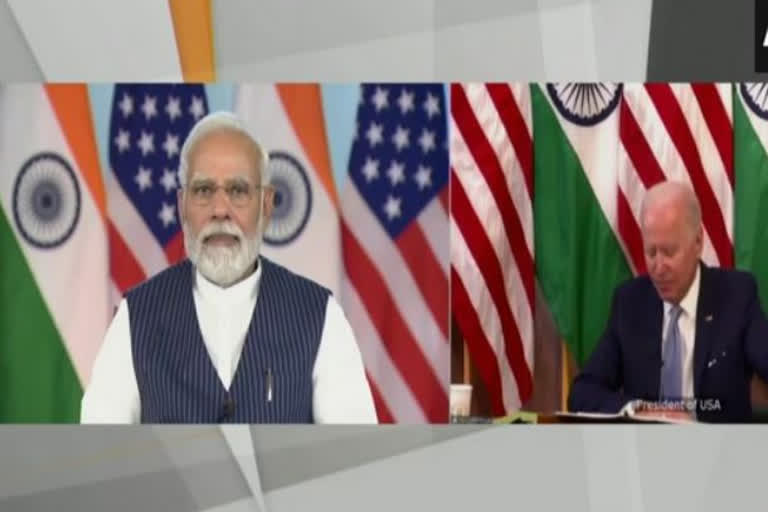New Delhi: The biggest takeaway of the agreements inked at the 4th India-US Ministerial 2+2 Dialogue on April 11, is the rather unusual scenario that the world’s two biggest democratic nations disagree on Russia in the aftermath of the latter’s military action on Ukraine that began on February 24 but strongly agree on a strong architecture and alliance to counter an increasingly powerful and assertive China.
No R-word
That India’s ‘strategically autonomous’ position on the Russian action in Ukraine prevailed can be gauged by the fact that Russia was not mentioned by name even once in the carefully-constructed 4,312-word joint statement issued. This was strange in view of the fact that the Russia-Ukraine conflict would have been among the top agenda items in the dialogue.
Nor did the statement go beyond the cursory “worsening humanitarian crisis in Ukraine”, seeking an “immediate cessation of hostilities”, and “condemnation” of civilian deaths in Ukraine. The groundwork to the joint statement was first laid by a virtual meeting on Monday (April 11) between PM Narendra Modi and President Joseph Biden followed by the dialogue between US secretary of state Antony J. Blinken and secretary of defense Lloyd J. Austin III with their respective Indian counterparts defence minister Rajnath Singh and external affairs minister S. Jaishankar.
Oil and Rights
But two sore points stood out—India’s refusal to stop oil imports from Russia and US’ criticism of human rights in India. The context was exemplified by what foreign minister Jaishankar had said after the 2+2 dialogue while responding to a query during the joint briefing on Monday: “If you are looking at energy purchases from Russia, I would suggest that your attention should be focused on Europe. We do buy some energy, which is necessary for our energy security. But I suspect looking at the figures, probably our total purchases for the month would be less than what Europe does in an afternoon.”
Pressed on the issue, White House Press Secretary Jen Psaki could only kowtow the Indian position when she said: “I’ll let Prime Minister Modi and the Indians speak to that. Again, it’s 1 to 2 per cent (Indian oil imports from Russia) at this point in time. They (India) import 10 per cent from the United States. It is not a violation of any sanctions or anything along those lines… The (oil) imports from the United States are already significant—or much bigger than the imports that they get from Russia.”
The Indians also glossed over the US’ criticism of the rights situation in India with both ministers—Singh and Jaishankar—preferring to turn a deaf ear to the accusation. Blinken had said on Monday after the dialogue: “We are monitoring some recent concerning developments in India including a rise in human rights abuses by some government, police and prison officials.”
Besides targeting India’s religious rights freedom, the US has also been critical of India’s Citizen’s Amendment Act (CAA) which fast-tracks Indian citizenship for non-Muslims who arrived in India from Bangladesh, Afghanistan, and Pakistan on or before December 31, 2014.
India’s growing influence
But India’s growing heft was evident in the joint statement on Afghanistan which demanded that “Afghan territory must never again be used to threaten or attack any country or to shelter or train terrorists, or to plan or finance terrorist attacks”. Also evident in the latest 2+2 dialogue was the dilution of the original mandate of the President Don Trump-initiated ‘Quadrilateral Security Dialogue’ or the ‘Quad’ which could have been an effective naval alliance to counter Chinese belligerence.
But there were some important gains with some forward movement on military and defence cooperation in the emerging fields of space, artificial intelligence (AI), and cyber. A key feature of the defence ties was the declared intention to build a comprehensive framework under which the militaries of both countries are equipped to exchange information in real time across domains.
Pointing out the emerging areas of India-US cooperation, Prof Kumar Sanjay Singh, who teaches history at a Delhi University college and is a keen follower of global strategic affairs, says: “US is seeking closer collaboration in a number of areas like space, Artificial Intelligence, cyber, naval including deep sea mapping and also unraveling an initiative of infrastructural development that can rival China’s massive Belt and Road Initiative (BRI).”
“An interesting aspect is that while there has been considerable divergence from the Donald Trump administration, there is some continuity too. For instance, take the 2+2 mechanism which is a Trump-Pompeo legacy,” he added. Less than a year ago in June 2021, President Joe Biden, at the G7 meet from a Carbis Bay resort in Cornwall, UK, had issued a clarion call with his “Build Back Better World” (3BW) plan which had two aims—to counter China’s BRI and to provide an infrastructural alternative to the nations of the world to China’s BRI.
Grabbing the first mover’s advantage, China has signed BRI MoUs with about 140 countries which includes countries in Sub-Saharan Africa, in Europe and Central Asia, in East Asia and the Pacific, in West Asia and North Africa, in Latin America and the Caribbean and in South East Asia. BRI is a replication of China's ancient Silk Road trade route that connected China to Asia and Europe but now railways, roads, seaports, and highways besides other infrastructure will command the connect.
Also read:India, US urge Taliban to follow UNSC resolution, call for cessation of violence in Myanmar



